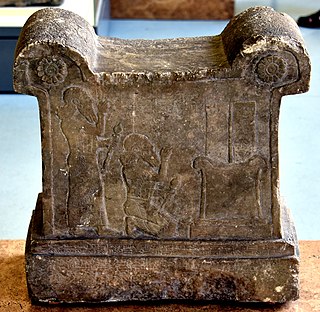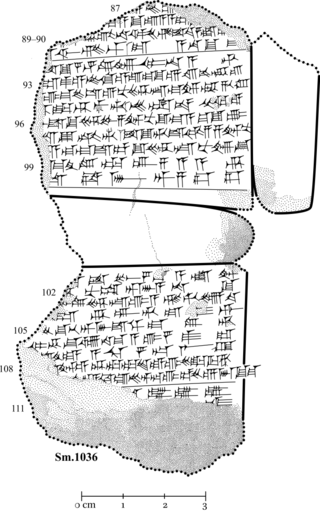Related Research Articles

Enlil, later known as Elil, is an ancient Mesopotamian god associated with wind, air, earth, and storms. He is first attested as the chief deity of the Sumerian pantheon, but he was later worshipped by the Akkadians, Babylonians, Assyrians, and Hurrians. Enlil's primary center of worship was the Ekur temple in the city of Nippur, which was believed to have been built by Enlil himself and was regarded as the "mooring-rope" of heaven and earth. He is also sometimes referred to in Sumerian texts as Nunamnir. According to one Sumerian hymn, Enlil himself was so holy that not even the other gods could look upon him. Enlil rose to prominence during the twenty-fourth century BC with the rise of Nippur. His cult fell into decline after Nippur was sacked by the Elamites in 1230 BC and he was eventually supplanted as the chief god of the Mesopotamian pantheon by the Babylonian national god Marduk.

Ninḫursaĝ sometimes transcribed Ninursag, Ninḫarsag, or Ninḫursaĝa, also known as Damgalnuna or Ninmah, was the ancient Sumerian mother goddess of the mountains, and one of the seven great deities of Sumer. She is known earliest as a nurturing or fertility goddess. Temple hymn sources identify her as the "true and great lady of heaven" and kings of Lagash were "nourished by Ninhursag's milk". She is the tutelary deity to several Sumerian leaders.
Akkadian literature is the ancient literature written in the Akkadian language in Mesopotamia during the period spanning the Middle Bronze Age to the Iron Age.

Anzû, also known as dZû and Imdugud, is a monster in several Mesopotamian religions. He was conceived by the pure waters of the Abzu and the wide Earth, or as son of Siris. Anzû was depicted as a massive bird who can breathe fire and water, although Anzû is alternately depicted as a lion-headed eagle.
Enkimdu (𒀭𒂗𒆠𒅎𒁺) was a Mesopotamian god associated with agriculture and irrigation. He is best known from the poem Dumuzid and Enkimdu, but in laments he was instead connected with the god Martu, who like Dumuzi could be described and depicted as a shepherd.
The Poor Man of Nippur is an Akkadian story dating from around 1500 BC. It is attested by only three texts, only one of which is more than a small fragment.
There was a man, a citizen of Nippur, destitute and poor,
Gimil-Ninurta was his name, an unhappy man,
In his city, Nippur, he lived, working hard, but
Had not the silver befitting his class,
Had not the gold befitting people .
His storage bins lacked pure grain,
His insides burned, craving food, and
His face was unhappy, craving meat and first-class beer;
Having no food, he lay hungry every day, and
Was dressed in garments that had no change.
In his unhappy mood, he thought to himself:
I'll strip off my garments which have no change, and
In my city of Nippur's market I'll buy a sheep!
So he stripped off his garments which had no change, and
In his city of Nippur's market he bought a three-year-old goat.
In his unhappy mood, he thought to himself:
Suppose I slaughter this goat in my yard-
There could be no feast, for where is the beer?
My friends in the neighbourhood would find out and be furious,
And my family and relatives would be angry with me.
Pabilsaĝ was a Mesopotamian god. Not much is known about his role in Mesopotamian religion, though it is known that he could be regarded as a bow-armed warrior deity, as a divine cadastral officer or a judge. He might have also been linked to healing, though this remains disputed. In his astral aspect, first attested in the Old Babylonian period, he was a divine representation of the constellation Sagittarius.
Ninimma was a Mesopotamian goddess best known as a courtier of Enlil. She is well attested as a deity associated with scribal arts, and is variously described as a divine scholar, scribe or librarian by modern Assyriologists. She could also serve as an assistant of the birth goddess Ninmah, and a hymn describes her partaking in cutting of umbilical cords and determination of fates. It has also been suggested that she was associated with vegetation. In the Middle Babylonian period she additionally came to be viewed as a healing deity.
The Dialogue of Pessimism is an ancient Mesopotamian literary composition in the form of a dialogue between a master and his slave. Its interpretations have varied, but it is generally considered an unusual text which thematises the futility of human action. It is an example of ancient Near Eastern wisdom literature.

Nuska or Nusku, possibly also known as Našuḫ, was a Mesopotamian god best attested as the sukkal of Enlil. He was also associated with fire and light, and could be invoked as a protective deity against various demons, such as Lamashtu or gallu. His symbols included a staff, a lamp and a rooster. Various traditions existed regarding his genealogy, with some of them restricted to texts from specific cities. His wife was the goddess Sadarnunna, whose character is poorly known. He could be associated with the fire god Gibil, as well as with various courtiers of Enlil, such as Shuzianna and Ninimma.
Shuzianna was a Mesopotamian goddess. She was chiefly worshiped in Nippur, where she was regarded as a secondary spouse of Enlil. She is also known from the enumerations of children of Enmesharra, while in the myth Enki and Ninmah she is one of the seven minor goddesses helping with the creation of mankind.

The work known by its incipit, Angim, "The Return of Ninurta to Nippur", is a rather obsequious 210-line mythological praise poem for the ancient Mesopotamian warrior-god Ninurta, describing his return to Nippur from an expedition to the mountains (KUR), where he boasts of his triumphs against "rebel lands" (KI.BAL), boasting to Enlil in the Ekur, before returning to the Ešumeša temple—to “manifest his authority and kingship.”

Gula was a Mesopotamian goddess of medicine, portrayed as a divine physician and midwife. Over the course of the second and first millennia BCE, she became one of the main deities of the Mesopotamian pantheon, and eventually started to be viewed as the second highest ranked goddess after Ishtar. She was associated with dogs, and could be depicted alongside these animals, for example on kudurru, and receive figurines representing them as votive offerings.
Ninnibru, also romanized as Nin-Nibru, was a Mesopotamian goddess regarded as the wife of Ninurta. She is attested in sources from between the Ur III and Kassite periods, including offering lists, the god list An = Anum, and the poem Angim. Later she came to be absorbed by Gula, and ceased to be worshiped as a separate deity.

Igalim or Igalimma was a Mesopotamian god from the local pantheon of the state of Lagash. He was closely associated with Ningirsu, possibly originating as the personification of the door of his temple, and was regarded as a member of his family. His older brother was Shulshaga and his mother was Bau, as already attested in Early Dynastic sources. Until the end of the Ur III period he was worshiped in Lagash and Girsu, where he had a temple, though he also appears in a number of later texts.
The Catalogue of Texts and Authors is a work of Akkadian literature. The Catalogue represents the most important Mesopotamian metatext: its compiler grouped together texts or text categories under the names of authors "from whose mouth" they purportedly stem. Works are ascribed to Ea, to antediluvian sages and semi-mythical kings; but also to famous family ancestors and scholars from a less remote past. Additionally, some compositions are said to result from divine revelation or from dictation by certain animals.
The Great Prayer to Šamaš is a piece of Akkadian literature.

Bullussa-rabi's Hymn to Gula is a piece of Akkadian literature.
Ištar 2, also called the Hymn to Ištar or the Great Ištar Prayer, is a piece of Akkadian literature. It is a long and elaborate prayer of the shuilla type. It was composed in the second millennium BC. Six Akkadian textual witnesses are known, but only one is complete. There is also an incomplete Hittite copy.
Bulluṭsa-rabi was a Babylonian author and āšipu who most likely lived in the Kassite period. While sources from the first millennium BCE indicate at the time it was assumed that Bulluṭsa-rabi was a man, and this assumption was also initially followed by Assyriologists, further research showed that all individuals bearing this name recorded in earlier sources were women. A composition known from Nineveh, the Catalogue of Texts and Authors, attributes the authorship of a well known hymn to Gula and a number of unidentified texts to her.
References
- ↑ Mitto, Tonio. "III.10 Hymn to Ninurta as Savior". electronic Babylonian Library. LMU München. Retrieved 8 March 2023.
- ↑ Lambert, W. G. (1959). The Sultantepe Tablets (A Review Article). Revue d’Assyriologie, 53, 119–138.
- ↑ Mitto, T. (2022). The Nippur Scholar Rīmūt-Gula and His Oeuvre. Kaskal, 19, 106–109.
- ↑ Mayer, W. R. (1992). Ein Hymnus auf Ninurta als Helfer in der Not. Orientalia, 61, 17–57.
- ↑ Gesche, P. D. (2001). Schulunterricht in Babylonien im ersten Jahrtausend v. Chr. Ugarit-Verlag.
- ↑ Mitto, T. (2022). A New Edition of the Catalogue of Texts and Authors. Kaskal, 19, 109–136.